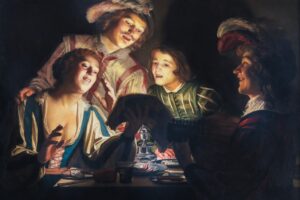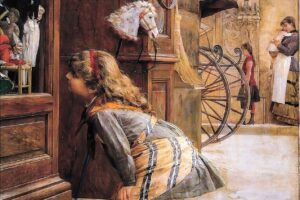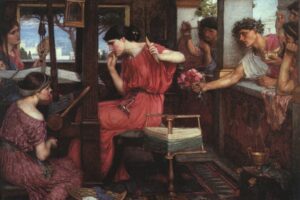Overview
In 1787, Jacques-Louis David unveiled The Death of Socrates, a commanding masterpiece of the Neoclassical movement. Painted during the rise of Enlightenment ideals, it captures the legendary philosopher’s final moments as he calmly accepts a cup of poison hemlock, condemned for impiety and corrupting the youth of Athens.
The scene is set in a stark prison chamber, where Socrates, bathed in light, gestures upward with unwavering conviction, symbolizing the triumph of reason and principle over fear and mortality. Around him, his students collapse in grief, their anguished bodies forming a dramatic contrast to his calm resolve. With clarity of line, monumental composition, and sculptural form, David revives the grandeur of classical antiquity while delivering a moral lesson on virtue, sacrifice, and truth.
More than a historical retelling, this painting became a beacon of civic virtue for revolutionary France, showing how a single life, lived with integrity, could inspire generations.
The Death of Socrates: Jacques Louis David, 1787
Wisdom on Trial, Conviction in Chains
Socrates, the great philosopher of Athens, was not a man who feared death. When charged with corrupting the youth and impiety, he stood before the court not with pleas, but with reason. Found guilty, he was sentenced to die by drinking hemlock. Jacques-Louis David, in thi
The Philosopher’s Poise
At the center of the canvas, Socrates sits upright, one hand lifted as if still teaching, the other reaching calmly for the cup of poison. His body is lit with divine clarity, muscular, noble, composed. Clothed in a simple white cloth, he glows like a martyr for wisdom. His expression shows no pain, no panic—only purpose. Even in death, he instructs.
Grief Surrounds Him
Around Socrates, his disciples weep. Some turn away, others cover their faces. One grips the philosopher’s thigh in despair. Another hides his eyes behind his hand, unable to witness the fate of the man he followed. Their robes—blue, red, gold—flow like waves around Socrates’ island of calm. The contrast is striking: emotion collapses while reason remains unshaken.
The Reluctant Hand
To the left, a young man holds out the cup. His head is bowed, his body tense. He cannot meet Socrates’ eyes. This is Crito, his loyal friend, the one who tried to convince Socrates to flee into exile. But Socrates refused. To him, justice mattered more than escape. Crito’s pain is personal, and David paints it with silent dignity.
Plato in Shadow
Near the edge, slumped and still, sits an old man—thoughtful, reserved. This is Plato, Socrates’ most famous student. Though historically inaccurate—Plato was not there when Socrates died—David includes him, placing him in deep thought. His face is turned down, his quill and scroll forgotten. He represents philosophy itself: reflecting, recording, enduring.
The Darkness Beyond
Behind the figures, the prison’s archway opens into deeper gloom. A few distant forms stand at the steps. The walls are bare, cold, and confining. Chains lie broken near the foot of the bed. Yet the scene is not bleak. The light falls clearly on Socrates, as if the heavens themselves approve. David uses light not to soften, but to declare: this is not the end—it is a legacy.
When Ideas Become Immortal
Socrates drank the poison, but his voice lives on. David’s painting reminds us that the body may perish, but the soul of truth, of courage, of unshakable conviction does not. It is a story of death, yes—but more so, a story of immortality born from integrity. A man may be silenced, but his ideas—like this painting—continue to speak across time.
About Artist

Jacques-Louis David (1748–1825) was a French painter who became the leading figure of Neoclassicism, a movement that rejected the frivolity of the Rococo and sought to revive the moral and aesthetic values of ancient Greece and Rome. His art was not just beautiful; it was a powerful tool for political and social change. David’s work defined a new style that was severe, intellectual, and deeply political, making him a central figure in the French Revolution and later, the court of Napoleon Bonaparte.
Artistic Style and Legacy
David’s style is characterized by a dramatic shift from the soft, sensual curves of Rococo to the sharp lines and moral clarity of Neoclassicism. His paintings are known for:
- Classical Themes and Heroes: He drew heavily from ancient history and mythology to tell stories of virtue, civic duty, and self-sacrifice.
- Sharp, Defined Lines: He rejected the loose brushwork of the Rococo in favor of crisp, sculptural forms that give his figures a sense of heroic grandeur.
- Moral and Political Messages: His art often served as propaganda, urging viewers to embrace patriotism and civic virtue.
- Controlled Lighting: He used strong, raking light to emphasize form and clarity, avoiding the dramatic tenebrism of the Baroque.
Artwork Profile
Here paintings represent the full range of his career, from his early Neoclassical masterpieces to his later works for Napoleon.
- Belisarius Begging for Alms (1781): An early Neoclassical work that depicts the Roman general Belisarius, unjustly fallen into disgrace, begging for money. It’s a clear moral statement about the cruelty of the state.
- The Lictors Bring to Brutus the Bodies of His Sons (1789): A powerful and stark depiction of a Roman leader who chose civic duty over personal love. This painting, with its clear composition and somber tone, was seen as a call for revolutionary sacrifice.
- The Farewell of Telemachus and Eucharis (1782): A more sentimental and intimate work from his early career, it depicts a scene from a classical novel, showing his softer side before his full turn to political subjects.
- The Death of Socrates (1787): One of his most famous masterpieces. It portrays the Greek philosopher Socrates as a moral hero calmly facing death. The painting’s noble composition and stoic emotion made it an icon of Enlightenment ideals.
- The Anger of Achilles (1819): This late painting, from his exile in Brussels, shows David returning to classical subjects with a more refined and emotionally charged style.
- Oath of the Horatii (1784): Arguably his most famous work and a manifesto of Neoclassicism. It depicts three Roman brothers swearing an oath to their father, prioritizing duty to Rome over family. Its stark, geometric composition and powerful moral theme made it an instant sensation.
- Napoleon Crossing the Alps (1801): A famous equestrian portrait of Napoleon as a heroic figure. The painting is a work of political propaganda, portraying Napoleon as a dynamic and determined leader.
- The Emperor Napoleon in His Study at the Tuileries (1812): A more intimate portrait of Napoleon, but one that still emphasizes his power and intellectual prowess. It shows the emperor standing in his study late at night, a subtle nod to his tireless work ethic.



